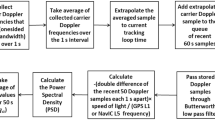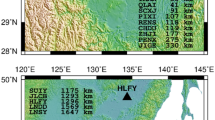Abstract
The impact of the phase-locked loop (PLL) bandwidth on the noise and correlations of GPS measurements sampled with a 100 Hz rate has been investigated using short and long baselines, and stationary or moving GPS rovers recording oscillations with known characteristics relative to “true” reference values. Data have been collected under various satellite constellations using various values of PLL bandwidth, particularly 25, 50, 100 Hz, and were processed in differential mode using different software packages. Analysis of standard deviations, spectra and autocorrelation functions of the differences between recorded and true displacements revealed that an increase in the PLL bandwidth leads to reduction in correlations and increase in low- and high-frequency noise of 100 Hz data. Optimal results can be obtained using either a pre-set 50 Hz PLL bandwidth or a 100 Hz PLL bandwidth combined with a posteriori band-pass filtering of the coordinates. Such optimal results permit accurate recording of high-frequency (>5 Hz), dynamic displacements of a few millimeters and indicate that 100 Hz data are useful for monitoring high-frequency structural vibrations, and also strong earthquake motions and high-frequency movements of vehicles.













Similar content being viewed by others
References
Avallone A, Marzario M, Cirella A et al (2011) Very high rate (10 Hz) GPS seismology for moderate-magnitude earthquakes: the case of the Mw 6.3 L’Aquila (central Italy) event. J Geophys Res 116(B2):B02305. doi:10.1029/2010JB007834
Bachmann H (1997) Vibration problems in structures: practical guidelines, 2nd edn. Birkhäuser, Basel
Boore DM, Bommer JJ (2005) Processing of strong-motion accelerograms: needs, options and consequences. Soil Dyn Earthq Eng 25(2):93–115. doi:10.1016/j.soildyn.2004.10.007
Braasch MS, Van Dierendonck AJ (1999) GPS receiver architectures and measurements. Proc IEEE 87(1):48–64. doi:10.1109/5.736341
Carden EP, Brownjohn JMW (2008) Fuzzy clustering of stability diagrams for vibration-based structural health monitoring. Comput Aided Civil Infrastruct Eng 23(5):360–372. doi:10.1111/j.1467-8667.2008.00543.x
Casciati F, Fuggini C (2011) Monitoring a steel building using GPS sensors. Smart Struct Syst 7(5):349–363
Chan W-S, Xu Y-L, Ding X-L et al (2006) Assessment of dynamic measurement accuracy of GPS in three directions. J Surv Eng 132(3):108. doi:10.1061/(ASCE)0733-9453
Genrich JF, Bock Y (2006) Instantaneous geodetic positioning with 10–50 Hz GPS measurements: noise characteristics and implications for monitoring networks. J Geophys Res 111(B3):B03403. doi:10.1029/2005JB003617
Häberling S, Rothacher M, Geiger A (2012) Assessment of high-rate GPS using a single-axis shake table. In: Proceedings of the European Geosciences Union (EGU) general assembly 2012, Vienna, Austria, 22–27 April
Han S, Rizos C (1997) Multipath effects on GPS in mine environments. In: 10th international congress of the International Society for Mine Surveying Fremantle, Australia
Herring T (2000) GLOBK: global Kalman filter VLBI and GPS analysis program, version 10.0. Massachusetts Institute of Technology, Cambridge
Kaplan ED, Hegarty CJ (2006) Understanding GPS: principles and applications. Artech House, Boston
Kashani I, Wielgosz P, Grejner-Brzezinska D (2007) The impact of the ionospheric correction latency on long-baseline instantaneous kinematic GPS positioning. Surv Rev 39(305):238–251. doi:10.1179/175227007X197156
Kumar-Tiwari S, Ravindra-Babu S, Kumar R (2011) Design of baseband processor for high dynamic GPS signals using higher order loops. Int J Mach Learn Comput 1(50):516–521
Lian P, Lachapelle G, Ma C (2005) Improving tracking performance of PLL in high dynamics applications. In: Proceedings of the 2005 national technical meeting of the institute of navigation, January 24–26, 2005. The Catamaran Resort Hotel, San Diego, CA, pp 1042–1052
Meng X (2002) Real-time deformation monitoring of bridges using GPS/accelerometers. The University of Nottingham, Institute of Engineering Surveying and Space Geodesy
Meng X, Dodson AH, Roberts GW (2007) Detecting bridge dynamics with GPS and triaxial accelerometers. Eng Struct 29(11):3178–3184. doi:10.1016/j.engstruct.2007.03.012
Moschas F, Steirou E (2013) Statistical estimation of changes in the dominant frequencies of structures in long noisy series of monitoring data. Math Probl Eng. doi:10.1155/2013/216860
Moschas F, Stiros S (2011) Measurement of the dynamic displacements and of the modal frequencies of a short-span pedestrian bridge using GPS and an accelerometer. Eng Struct 33(1):10–17. doi:10.1016/j.engstruct.2010.09.013
Moschas F, Stiros S (2013a) Phase effect in time-stamped accelerometer measurements—an experimental approach. Int J Metrol Qual Eng 3(3):161–167. doi:10.1051/ijmqe/2012025
Moschas F, Stiros S (2013b) Noise characteristics of high-frequency, short-duration GPS records from analysis of identical, collocated instruments. Measurement 46(4):1488–1506. doi:10.1016/j.measurement.2012.12.015
Moschas F, Stiros SC (2014) Three-dimensional dynamic deflections and natural frequencies of a stiff footbridge based on measurements of collocated sensors. Struct Control Health Monit 21(1):23–42. doi:10.1002/stc.1547
Ogaja C, Satirapod C (2007) Analysis of high-frequency multipath in 1-Hz GPS kinematic solutions. GPS Solut 11(4):269–280. doi:10.1007/s10291-007-0058-8
Psimoulis P, Stiros S (2012) A supervised learning computer-based algorithm to derive the amplitude of oscillations of structures using noisy GPS and Robotic Theodolites (RTS) records. Comput Struct 92–93:337–348. doi:10.1016/j.compstruc.2011.10.019
Psimoulis P, Pytharouli S, Karambalis D, Stiros S (2008) Potential of Global Positioning System (GPS) to measure frequencies of oscillations of engineering structures. J Sound Vib 318(3):606–623. doi:10.1016/j.jsv.2008.04.036
Razavi A, Gebre-Egziabher D, Akos DM (2008) Carrier loop architectures for tracking weak GPS signals. IEEE Trans Aerosp Electron Syst 44(2):697–710. doi:10.1109/TAES.2008.4560215
Roberts G, Meng X, Dodson A, Cosser E (2002) Multipath mitigation for bridge deformation monitoring. J Glob Position Syst 1(1):25–33
Roberts G, Cosser E, Meng X, Dodson A (2004) High frequency deflection monitoring of bridges by GPS. J Global Position Syst 3(1–2):226–231
Smalley R (2009) High-rate GPS: how high do we need to go? Seismol Res Lett 80(6):1054–1061. doi:10.1785/gssrl.80.6.1054
Wolf H (1979) Ausgleichungs Rechnung II. Aufgaben und Beispiele zur praktischen Anwendung. Dummlers Verlag, Bonn
Yi T-H, Li H-N, Gu M (2013) Experimental assessment of high-rate GPS receivers for deformation monitoring of bridge. Measurement 46(1):420–432. doi:10.1016/j.measurement.2012.07.018
Acknowledgments
Thomas Herring is highly thanked for his guidance on processing the GPS data using TRACK and for his suggestions for the experimental procedure. Fanis Moschas was funded by the Karatheodori 2009 research program of the University of Patras (Program code: C-898). The manuscript was significantly improved after comments by two anonymous reviewers.
Author information
Authors and Affiliations
Corresponding author
Rights and permissions
About this article
Cite this article
Moschas, F., Stiros, S. PLL bandwidth and noise in 100 Hz GPS measurements. GPS Solut 19, 173–185 (2015). https://doi.org/10.1007/s10291-014-0378-4
Received:
Accepted:
Published:
Issue Date:
DOI: https://doi.org/10.1007/s10291-014-0378-4




